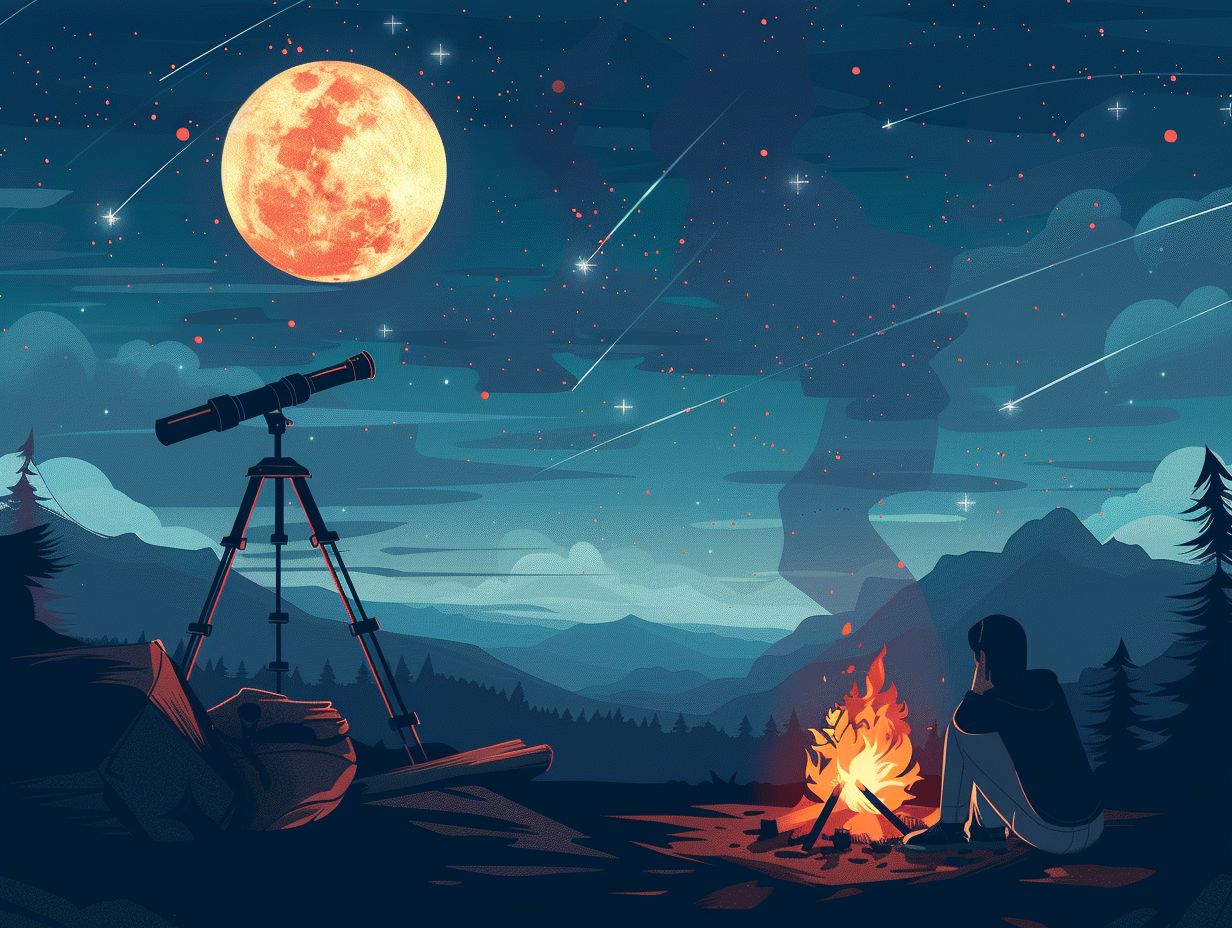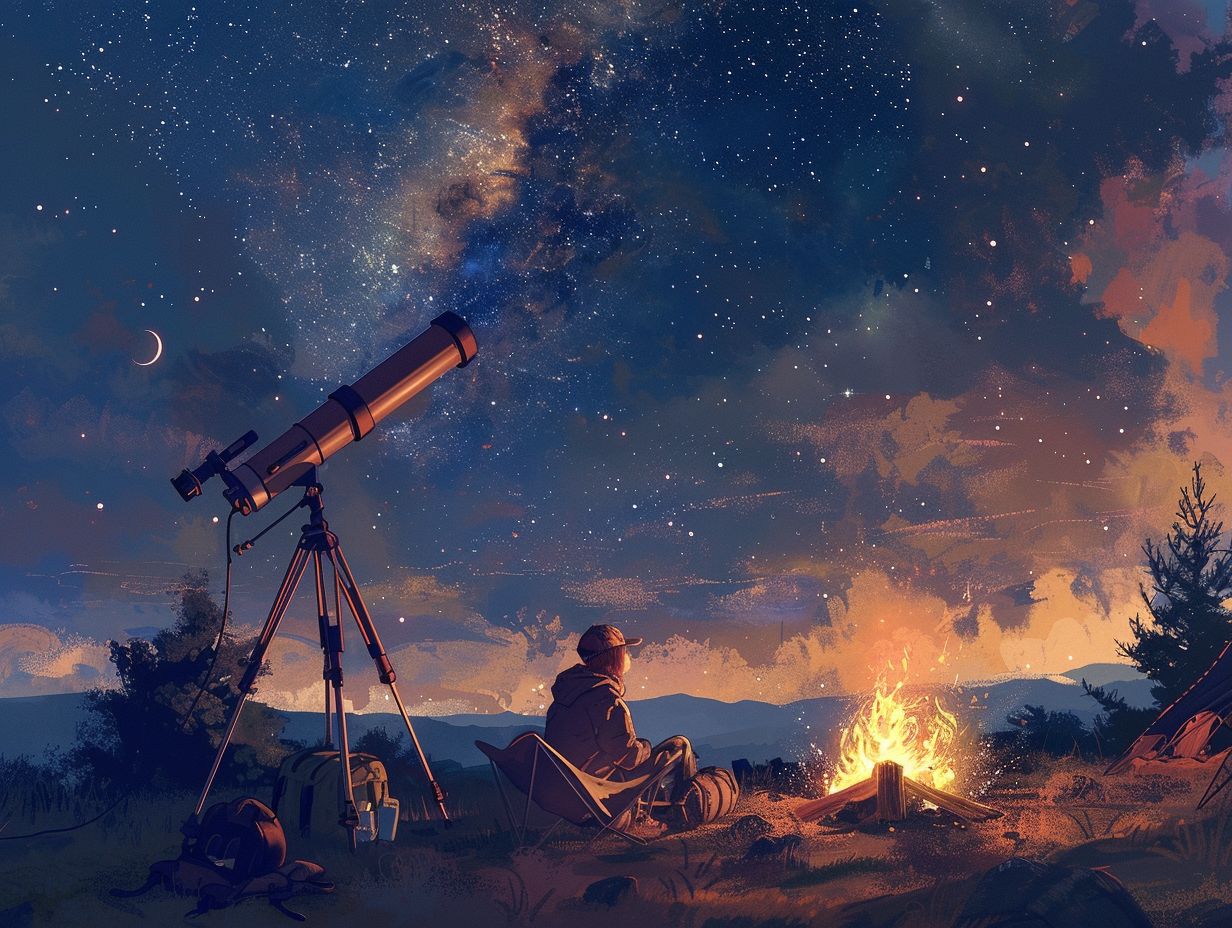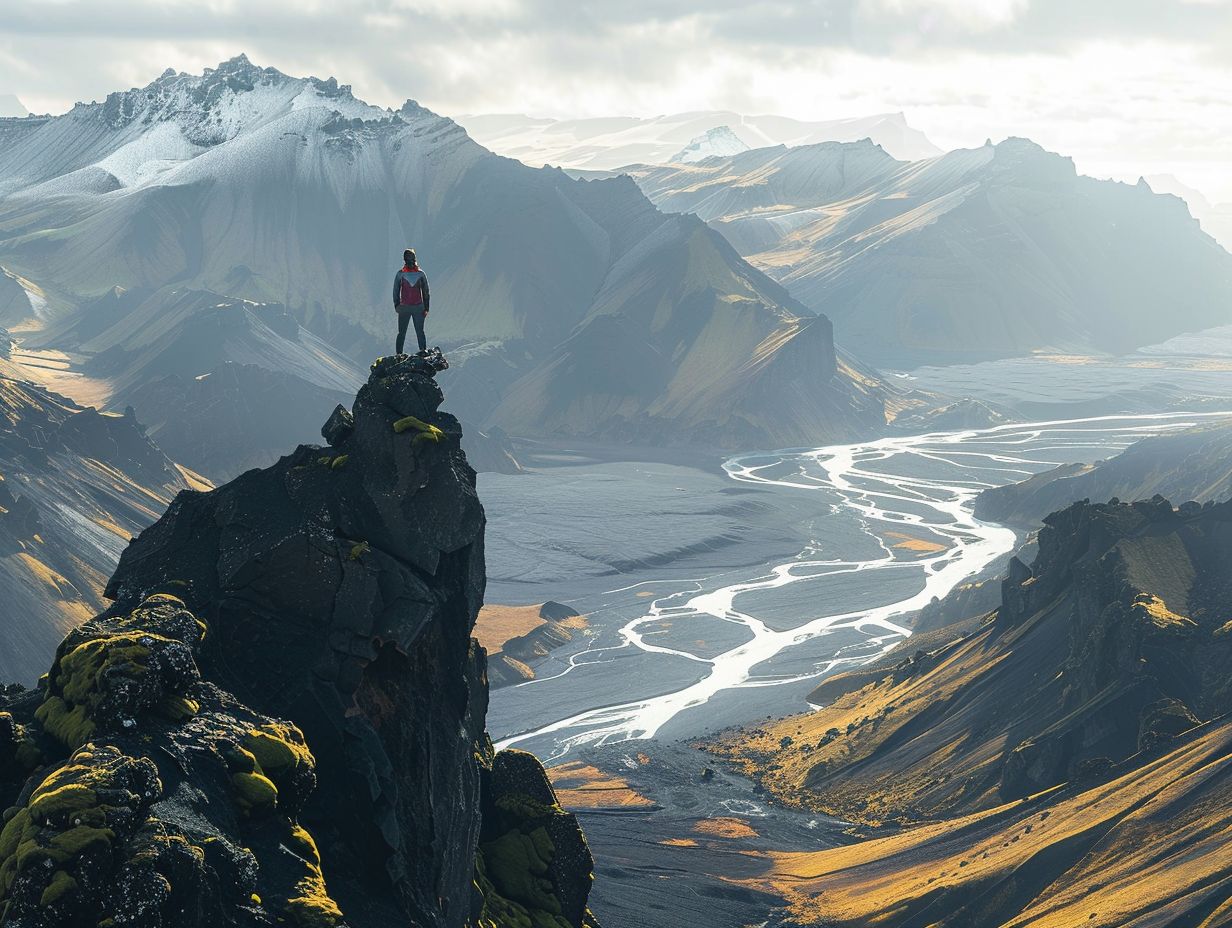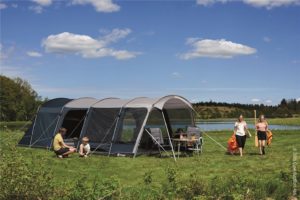

Vaibhav
- Categories: Advice
Are you a stargazing enthusiast looking to elevate your experience while camping? Look no further!
In this article, we will discuss the essential gear you need for a successful stargazing adventure, including telescopes, binoculars, and star charts.
We will also explore popular stargazing spots for camping and provide tips to make the most out of your stargazing experience.
So grab your gear and get ready to gaze at the stars in the great outdoors!
Key Takeaways:
 1.
1.
- Choose a stargazing location with minimal light pollution and a clear view of the sky.
- Essential gear for stargazing while camping includes a telescope, binoculars, star chart, red light headlamp, and portable power source.
- Additional gear for comfort and convenience includes camping chairs or blankets, insect repellent, warm clothing and blankets, and snacks and drinks.
Essential Gear for Stargazing while Camping
For an optimal stargazing experience during camping, it is essential to possess the appropriate gear. This enables the observer to discern star patterns and constellations with precision and efficiency. High-quality stargazing tents, telescopes, and binoculars are essential tools for closely examining the night sky and engaging in activities such as the Nikon Photo Contest.
1. Telescope
A telescope serves as an essential tool for the observation of celestial objects, enabling individuals to view distant astronomical entities with a high level of clarity and detail, particularly when paired with superior lenses designed for astrophotography. There is a diverse array of telescopes available to cater to the varied requirements and preferences of astronomers and enthusiasts.
Refractor telescopes are recognised for their uncomplicated construction and adaptability, rendering them well-suited for individuals at the novice level.
Conversely, Reflectors offer larger aperture sizes at comparatively lower costs, making them ideal for the observation of fainter celestial bodies. Catadioptric telescopes combine the advantages of both refractors and reflectors, furnishing compact designs while maintaining a high level of performance.
The selection of an appropriate telescope featuring top-tier lenses is paramount for astrophotography, as it directly influences the sharpness and precision of captured images.
2. Binoculars
Binoculars offer a versatile and portable solution for stargazing, providing a wide field of view that can facilitate the exploration of the night sky and the identification of constellations. Their compact dimensions make them convenient for transportation during stargazing excursions, enabling users to visit various locations without the bulk associated with a telescope.
The user-friendly design of binoculars allows individuals, including novices, to quickly acquire the skills needed to focus and adjust the device, thereby enhancing their stargazing endeavours.
When selecting binoculars for stargazing purposes, it is advisable to look for specific features, such as a wide enough aperture to capture a good amount of light, a high magnification power for clearer views, and a robust construction capable of withstanding outdoor conditions and potential impacts.
Optics of superior quality, equipped with multi-coated lenses, are essential for ensuring the production of sharp and bright images when observing celestial phenomena.
3. Star Chart or Guide

A star chart or guide serves as a valuable aid for individuals engaging in stargazing activities, assisting them in identifying star patterns and constellations within the night sky. There exists a variety of star charts and guides on the market, spanning from conventional printed maps to interactive mobile applications.
While printed star charts offer a classic method of navigating the celestial sphere, mobile applications such as SkySafari or Stellarium deliver real-time tracking capabilities and augmented reality functionalities.
Effectively utilising these tools entails an initial phase of acquainting oneself with the chart’s layout and comprehending how to align it with the surrounding environment.
Employing a red torch is recommended to preserve night vision during chart perusal, and engaging in the practice of locating pivotal stars or landmarks can aid in directing observations.
4. Red Light Headlamp
A red light head torch proves to be a vital tool for stargazing purposes as it offers the necessary illumination required without impacting one’s night vision.
The red light emitted by such head torches aids in the preservation of the natural ability to perceive in low-light conditions, facilitating easier navigation in the dark while expediting the adjustment of the eyes to darkness.
In the selection of a top-grade red light head torch for stargazing, it is imperative to consider various factors including brightness levels, battery longevity, durability, and comfort.
It is advisable to opt for a head torch equipped with adjustable brightness settings to tailor the light output according to specific requirements. Additionally, ensuring a comfortable fit is crucial to mitigate any discomfort that may arise during prolonged usage.
5. Portable Power Source
A portable power source is essential for ensuring that electronic devices, such as telescopes and cameras, remain charged during stargazing sessions.
This convenience allows individuals to capture stunning celestial images and stay connected with astronomy apps without the concern of running out of battery power.
When engaging in camping activities, a portable power source serves as a crucial companion, providing the flexibility to charge phones for emergencies, operate LED lights, or run small appliances.
The market offers a variety of options, including solar-powered chargers and compact power banks, allowing users to select a solution that aligns with their specific needs and lifestyle.
Investing in a dependable portable power source enhances outdoor experiences, guaranteeing that individuals never miss an opportunity to explore the night sky or maintain connectivity while in remote locations.
Additional Gear for Comfort and Convenience
Incorporating additional gear alongside basic stargazing equipment can greatly enhance your camping experience, ensuring sufficient preparation for an evening spent under the night sky. Essential items such as ergonomic camping chairs, insulating blankets, and insect repellents tested for effectiveness from respected brands like Yeti, Coleman SkinSmart, and Laird Superfood are essential for a pleasant and enjoyable stargazing trip.
1. Camping Chairs or Blankets
Comfortable camping chairs or warm blankets are vital for creating a comfortable stargazing experience, enabling individuals to sit or lie down in a relaxed manner while observing the night sky.
When choosing camping chairs for stargazing, it is advisable to seek models that feature built-in cup holders and sturdy armrests to enhance convenience. Additionally, blankets constructed from soft fleece or insulated materials offer warmth during cold evenings spent beneath the stars.
Prominent online retailers such as REI and Amazon present a diverse array of camping chairs and blankets that are specifically suited for stargazing excursions. Whether one favours a reclining chair or a lightweight blanket, these essential accessories contribute to heightened comfort and elevate the overall enjoyment of the stargazing activity.
2. Insect Repellent
A reliable insect repellent, such as Coleman SkinSmart, plays a vital role in safeguarding individuals against insect nuisances during stargazing activities, thereby enabling them to concentrate on celestial observations without disruptions.
Plus mitigating the discomfort associated with insect bites, these products serve a dual purpose by shielding individuals from potential insect-transmitted diseases like West Nile virus or Lyme disease, which are commonly spread by mosquitoes and ticks.
The preemptive application of insect repellent before embarking on a camping excursion establishes a protective barrier between individuals and bothersome insects, facilitating an immersive engagement with the natural environment with a sense of tranquility.
With its enduring formulation, Coleman SkinSmart ensures sustained protection throughout the night, rendering it a dependable companion for all outdoor enthusiasts seeking an uninterrupted experience in nature.
3. Warm Clothing and Blankets
Adequate attire, such as warm clothing and blankets, is crucial for stargazing, particularly on cooler nights, to ensure comfort and enable focused observation of the stars.
Utilising thermal base layers beneath clothing can offer additional insulation and aid in retaining body heat. It is advisable to wear a fleece or insulated jacket to effectively trap warmth while avoiding excessive bulk. Merino wool socks and gloves are excellent choices to keep extremities warm, and the inclusion of a cosy hat can minimise heat loss from the head.
In terms of blankets, wool or down-filled options are optimal for enhancing warmth during stargazing sessions. Layering blankets akin to a cocoon can effectively trap heat between the layers, ensuring sustained comfort throughout the night.
4. Snacks and Drinks

Maintaining a selection of snacks and beverages, which includes hydration options and caffeine offerings from reputable brands such as Yeti and Laird Superfood, can contribute to keeping individuals refreshed and invigorated during their stargazing excursions.
Snack items like trail mix, granola bars, and dried fruits serve as convenient sources of quick energy without causing a feeling of heaviness. These can be complemented with electrolyte-enriched water or coconut water to ensure adequate hydration while admiring the celestial wonders.
To introduce a touch of stimulation, individuals may wish to include cold brew coffee from Stumptown or energy-boosting teas from Yogi in their provisions.
Not only do these beverages aid in maintaining alertness, but they also contribute to a sense of comfort and warmth in the stargazing setting. It is important to recognise that a well-thought-out selection of snacks and drinks has the potential to elevate the overall stargazing experience.
Tips for Stargazing while Camping
Observing the night sky during a camping trip can be a gratifying endeavour when certain key guidelines are adhered to. These include:
- Monitoring the weather forecast
- Strategically scheduling your viewing time
- Utilising a star chart to accurately pinpoint constellations
Incorporating these measures will undoubtedly contribute to a memorable and pleasurable nocturnal experience beneath the celestial canopy.
1. Check the Weather
It is imperative to check the weather forecast before embarking on a stargazing excursion to ensure optimal viewing conditions and clear skies. Selecting nights with minimal cloud cover is essential, as clouds can obstruct visibility of the stars.
Monitoring the moon phase is also crucial, as a bright moon can diminish the visibility of fainter stars. Enhancing your stargazing experience can be achieved by scheduling sessions during nights with a new moon or a waning crescent phase.
Additionally, it is advisable to observe the atmospheric conditions carefully, as turbulence in the atmosphere can distort the starlight. Remaining well-informed about weather patterns is key to maximising the likelihood of experiencing an exceptional night beneath the stars.
2. Plan Your Viewing Time
Purposefully planning the timing of stargazing excursions in alignment with lunar phases and optimal visibility periods for celestial occurrences can significantly enhance the stargazing experience.
For an enhanced stargazing experience, it is advisable to arrange outings during the new moon phase when the sky is at its darkest, allowing stars to radiate more brilliantly.
Additionally, keeping a lookout for meteor showers or eclipses is recommended, as these infrequent events can provide remarkable displays in the nocturnal sky.
To maximise the enjoyment of stargazing sessions, selecting a site distant from urban light sources to minimise light pollution is crucial. Furthermore, bringing along a telescope or binoculars enables a closer examination of celestial entities.
It is essential to ensure adequate warmth by dressing appropriately and having a comfortable blanket or chair for relaxation while gazing at the celestial marvels above.
3. Allow Your Eyes to Adjust to the Dark
It is crucial to allow one’s eyes to adapt to darkness for effective stargazing, as this adjustment enhances the ability to perceive faint stars and celestial objects.
When transitioning from a well-illuminated area to a darker environment, it typically takes around 20-30 minutes for the eyes to fully acclimatise to the reduced light levels.
During this period, the pupils enlarge, enabling more light to enter the eye, while the rod cells in the retina heighten their sensitivity. To optimise night vision, it is advisable to refrain from gazing directly at bright sources of light and instead utilise red light, which does not interfere with the adaptation process.
Furthermore, limiting exposure to screens and artificial lighting prior to stargazing can also enhance one’s capacity to perceive objects in low-light conditions.
4. Use a Star Chart to Identify Constellations
Using a star chart can facilitate the identification of constellations and other celestial entities in the night sky, thereby enriching one’s stargazing experience with educational and recreational value.
These practical instruments are specifically crafted to delineate the spatial arrangement of stars, planets, and other cosmic entities at precise temporal and spatial coordinates. Proficiency in interpreting a star chart enables individuals to navigate through the expanse of the night sky effortlessly.
A useful technique involves aligning one’s orientation with the corresponding cardinal direction on the chart to accurately pinpoint constellations. Familiarizing oneself with the essential components of a star chart, such as cardinal points and pertinent celestial coordinates, can amplify the depth and quality of one’s stargazing excursion.
Take Breaks and Enjoy the Scenery
Integrating brief interludes into one’s stargazing session to appreciate the natural surroundings and partake in the experience with companions has the potential to forge enduring memories.
Engaging with the splendour of the star-studded sky can become even more rewarding when individuals convene with loved ones, identifying constellations and exchanging anecdotes beneath the celestial expanse.
These instances of camaraderie provide a feeling of solidarity and fellowship, strengthening the rapport between participants. The shared amazement and marvel elicited by observing shooting stars or contemplating the vastness of the cosmos collectively can nurture a sense of unity that transcends ordinary discourse, culminating in a distinctive and indelible social encounter.
Frequently Asked Questions

What is the best type of telescope for stargazing while camping?
The best type of telescope for stargazing while camping is a compact and portable one, such as a tabletop or travel telescope. These types of telescopes are easy to transport and set up, making them perfect for camping trips.
Do I need a tripod for stargazing with a telescope?
Yes, a tripod is essential for stargazing with a telescope. It helps stabilise the telescope and allows for more precise and comfortable viewing. Look for a lightweight and compact tripod that is easy to set up and transport.
What type of sleeping gear is best for stargazing while camping?
The best sleeping gear for stargazing while camping is a sleeping bag with a clear top or a camping hammock. Both options allow for unobstructed views of the night sky while keeping you warm and comfortable.
Is a red flashlight necessary for stargazing?
Yes, a red flashlight is necessary for stargazing as it helps preserve your night vision. Red light has a longer wavelength and is less harsh on the eyes compared to white light, making it easier to see stars and constellations in the dark.
What clothing should I wear for stargazing while camping?
You should wear warm and comfortable clothing for stargazing while camping, such as a fleece jacket, thermal layers, and insulated pants. It is also important to have a waterproof and windproof outer layer in case of unexpected weather.
Are there any essential accessories for stargazing while camping?
Yes, there are a few essential accessories for stargazing while camping, including a star chart or astronomy app to help you identify and locate celestial objects, a comfortable camping chair for extended stargazing sessions, and a power bank or solar charger to keep your electronic devices charged.
Share:
By submitting your email address, you are agreeing to receive marketing emails from theexpertcamper.co.uk.
We’ll never share your email address and you can unsubscribe at any time. Privacy policy
Related Posts

A Seasonal Guide To Hiking In The Peak District
Are you ready to lace up your hiking boots and explore the stunning landscapes of the Peak District? This seasonal guide will take you through

Hiking Challenges Preparing For Your First Ultrahike
Are you ready to take your hiking adventures to the next level? Ultra-hiking offers a unique combination of physical and mental challenges, breathtaking scenery, and

Ecofriendly Hiking Tips For Sustainable Adventures
Are you an outdoor enthusiast looking to minimise your impact on the environment while enjoying the great outdoors? Eco-friendly hiking is the perfect solution! We

The Best Hiking Trails For Experiencing UK Wildlife
When exploring the picturesque hiking trails of the UK, you can expect to encounter a diverse array of wildlife. From majestic birds soaring overhead to

Wildflower Walks The Best Trails For Nature Lovers
Are you a nature lover looking to embark on a wildflower walk? Explore the best trails for wildflower walks, including [Trail Name 1], [Trail Name

























